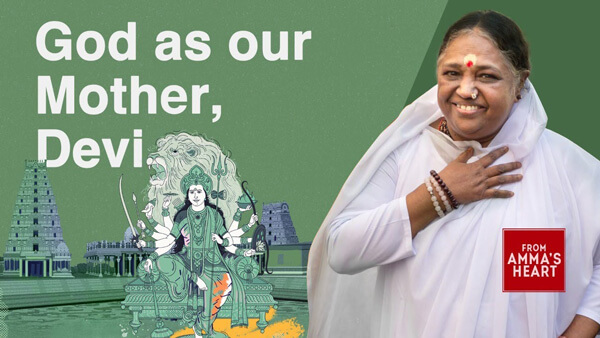Since ancient times, the tradition of worshipping the Supreme in the feminine — as the Mother — has been prevalent in India as well as in some other regions of the world. All four Vedas praise the Parasakti — the feminine energy. This can be seen in the Vedic hymns like Durga Suktam, Sri Suktam, etc.
Our mind is mostly influenced by tamoguna. We all love to enjoy the cosiness of sleep. Only when the mind is told, “Wake up and work! Otherwise you will perish!”. This idea needs to be contemplated to acquire the strength to move forward.
The mind is like water; it always flows downwards. Even if waterfalls on the top of a mountain, it will still flow downwards. But fire always burns upward. Even if you turn a flame upside down, it will still burn upwards. It can vaporize and uplift water. So the fire denotes awareness and the water denotes the downward flow of our mind. The mind is always searching for materialistic comforts. We have to awaken the mind with the fire of inner awareness. We have to take a firm resolution to move forward.
Even though we’ve grown physically, our mind is childish. It is with rajoguna, one has to win over tamoguna. Devi helps with that.
With Devi’s grace, we will be able to overcome any karmic fruits generated by us in the past. When a child senses danger, it will cry out to its mother. The mother will then come running to its rescue. Similarly, when facing life’s turmoil, Devi is the devotee’s sole refuge.
A mother is someone who only thinks about the welfare of her children. When the mother grows old, maybe she has some expectations from her children. But when the children are small, she has no such expectations. She only wants them to be happy and to make progress. Devi always comes running to protect Her children. It is said that She answers our call instantly.
Since ancient times, the tradition of worshipping the Supreme in the feminine — as the Mother — has been prevalent in India as well as in some other regions of the world. In fact, many of Amma’s children from different parts of the world have brought forms of the Divine Mother as was worshipped in their ancient traditions. All four Vedas praise the Parasakti — the feminine energy. This can be seen in the Vedic hymns like Durga Suktam, Sri Suktam, etc.
In the Ramayana, Lord Rama invokes Goddess Durga for victory over Ravana. Similarly, as instructed by Lord Krishna, the Pandavas worship Goddess Durga for victory in the Mahabharata War. In order to wed Lord Krishna, the gopis invoke Goddess Durga. All this goes to show just how ancient the tradition of Devi worship is in our culture. Sanatana Dharma gives each individual the freedom to worship God in whatever manifestation or mood he likes.

